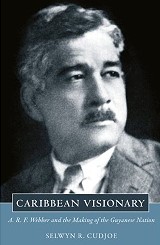Days of the sahib
are over,
or should be,
now that our land is free of the
overlord’s yoke
Rajkumari Singh

The novel “Those That Be In Bondage: A Tale of Indian Indenture and Sunlit Western Waters” written by A. R. F. Webber was published in 1917, the same year in which the indentureship scheme, that kept “those that be in bondage”, was abolished.
So there are two noticeable anniversaries here to commemorate: the centennial end to indentureship and the centennial publication year of the novel. The third celebration (hitherto unsung) is found in the fact that such a book – a piece of fiction – was published locally by The Daily Chronicle Printing Press. In 1917, that was a remarkable and commendable undertaking even though the author exerted enormous influence on society as a journalist and editor of the Daily Chronicle, among other hats he wore.
This novel is also notable because it falls at the beginning of the novel writing tradition of three states – the Caribbean, Tobago and Guyana, each state staking a claim to the novel. In the Caribbean, it is at the beginning of its novel tradition as there is but one other novel published before this one under review; in Tobago, where as the author was born, it is the first novel for that country; and in Guyana, it is one of the early novels of this country where the author lived, died and was buried.
To appreciate the first anniversary, a sketch of the indentureship scheme would be useful at this point. Emancipation of enslaved Africans in 1838 created a shortage of cheap labour. That vacuum was filled by Indian immigrant labour after other sources of immigrant labour did not effectively fit the bill. The scheme came to an end, but not after unimaginable suffering due to various forms of bondage and discrimination.
The narrative of this novel is straightforward, but the reading is not uncomplicated due mainly to the distracting language replete with circumlocution, constant author’s intrusion lending to much (too much) philosophizing and too much tour guiding but it is a satisfying read on many other levels.
When it was published at the start of the twentieth century, it would have made wonderful reading suited to the taste of the time – romanticism.
The better aspect of the book is found in its themes – the imbalance of female to male population on the sugar plantation and its attendant ills, and the moral fight against all forms of bondage especially colonial bondage, social bondage and spiritual bondage. The plot of the book rests heavily on physical and spiritual bondage.
Set in Guyana, Tobago and Trinidad, between 1890 and 1913, it traces two generations of the Walton family wherein the protagonist always seems to be on the run – he runs from Guyana to Tobago, from Tobago to Trinidad and back to Guyana. And the book ends with him contemplating running to London after it was suggested that he was responsible for the destruction by fire of the Brickdam Cathedral. The ‘run’ was designed to focus on the issue of various types of bondage.
The story opens on a sugar plantation in Guyana where the brother-in-law John James Walton, Edwin Hamilton, marries Bibi – “that smooth-skinned, bare-toed East Indian young lady”. The union produces a daughter, Marjorie, “and the rest of the text is taken up with the romantic love that develops between Harold Walton and Marjorie on the idyllic island of Tobago”. Harold eventually becomes a priest but had to free himself of that yoke when he becomes romantically involved with Marjorie.
-
R. F. Webber was born on the island of Tobago on January 1, 1880, to James Francis Webber and Sarah nee Hope. He married Beatrice Elizabeth Glasford, a union that produced Ivy Forbes Webber and Edith Forbes Webber.
Some twenty years after he was born, he came to live in British Guiana at a crucial and exciting period of its history. In his own words, he described that era as not being “jejune or insipid”. He was a witness to many changes and innovations like the introduction of the electric tram service, the 1905 and 1924 riots, the end to East Indian Immigration, the first issue of $1 and $2 paper money, educational reforms, the great rice embargo, glory days of sugar and its greatest decline, and the “abrogation of the 1891 Constitution”.
-
R. F. Webber was a poet, short story writer and novelist; herein the world of books, he made the most telling contribution to this land.
Responses to this author telephone (592) 226-0065 or email: oraltradition2002@yahoo.com



